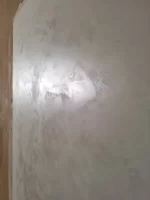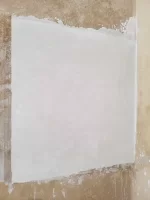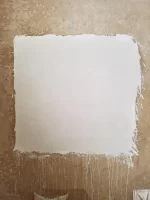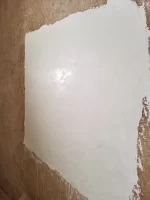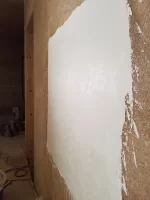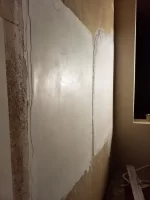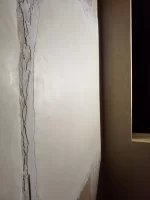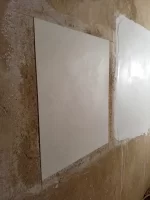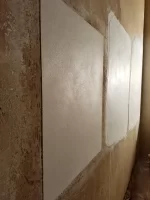Woods
Active Member
I'm trying to get a nice finish so that painting is not a requirement.
I'm using quicklime powder and marble dust (<300 micron) at a 1:3 ratio (after slaking this is closer to a 2:3 ratio). I'm using a marshalltown carbon steel trowel which is pretty well worn in.
What I'm after is a soft, even satin gloss, not a mirror. The problem I'm having currently is that the sheen is uneven. When I'm polishing, it seems that my blade misses certain patches. Pushing harder and using some water gets it more even, but then I get more discolouration and also too much of a mirror effect.
One thing that has been moderately succesful is using a polishing cloth when the plaster is reasonably firm but still green. This evens out the sheen a bit, but not enough. At this stage the plaster is too firm already to really have a stong effect. If it polish with the cloth earlier, it doesn't work because it scratches the plaster and brings too much of the marble dust to the surface.
My guess is that I need a much thinner blade and perhaps a smaller trowel too during the polishing stage when the plaster is firm but still malleable. I haven't worked with a flexi trowel yet so I was wondering if my assumption is correct before purchasing one.
I've also read in some places that since the top coat of fine lime plaster is applied so thin (<1mm), it is better to use a flexible blade for putting it on as well. Apparently it speeds up the spreading process. I'm not after the flattest possible finish ever because it really doesn't matter when we're talking less than a millimeter. My basecoat is dead flat within 1mm tolerance already, the final coat is really just about the aesthetic.
Perhaps I'm not skilled enough yet, but the marshalltown carbon steel doesn't get me the sheen that I'm after. Should I purchase a flexi and see what that does?
I'm using quicklime powder and marble dust (<300 micron) at a 1:3 ratio (after slaking this is closer to a 2:3 ratio). I'm using a marshalltown carbon steel trowel which is pretty well worn in.
What I'm after is a soft, even satin gloss, not a mirror. The problem I'm having currently is that the sheen is uneven. When I'm polishing, it seems that my blade misses certain patches. Pushing harder and using some water gets it more even, but then I get more discolouration and also too much of a mirror effect.
One thing that has been moderately succesful is using a polishing cloth when the plaster is reasonably firm but still green. This evens out the sheen a bit, but not enough. At this stage the plaster is too firm already to really have a stong effect. If it polish with the cloth earlier, it doesn't work because it scratches the plaster and brings too much of the marble dust to the surface.
My guess is that I need a much thinner blade and perhaps a smaller trowel too during the polishing stage when the plaster is firm but still malleable. I haven't worked with a flexi trowel yet so I was wondering if my assumption is correct before purchasing one.
I've also read in some places that since the top coat of fine lime plaster is applied so thin (<1mm), it is better to use a flexible blade for putting it on as well. Apparently it speeds up the spreading process. I'm not after the flattest possible finish ever because it really doesn't matter when we're talking less than a millimeter. My basecoat is dead flat within 1mm tolerance already, the final coat is really just about the aesthetic.
Perhaps I'm not skilled enough yet, but the marshalltown carbon steel doesn't get me the sheen that I'm after. Should I purchase a flexi and see what that does?

